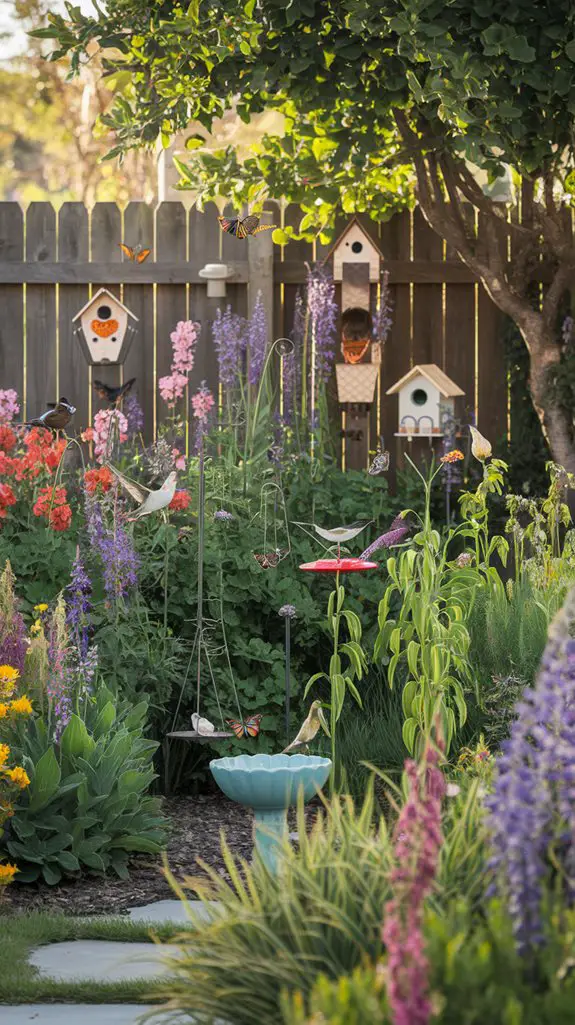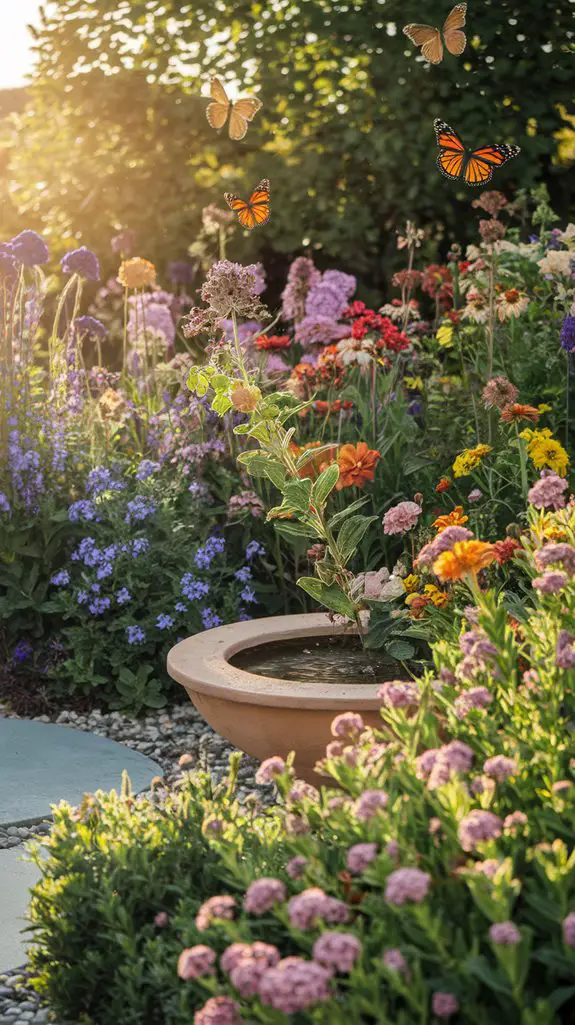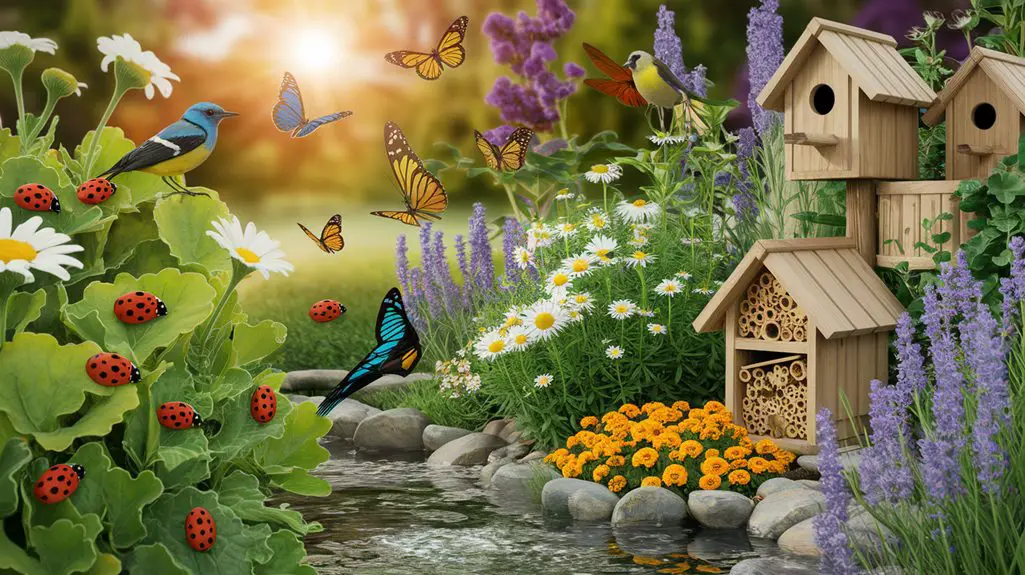When garden nuisances visit your carefully tended plants, you don’t need to reach for chemical solutions. Your yard can become a thriving ecosystem where nature’s own pest management team works round the clock on your behalf. Birds devour caterpillars, ladybugs feast on aphids, and toads consume slugs—all without charging for their services. By creating the right environment, you’ll discover how these wild allies can transform your garden while solving pest problems naturally.
The Benefits of Wildlife-Based Pest Management
While chemical pesticides remain popular among homeowners, wildlife-based pest management offers a more sustainable and environmentally friendly approach to controlling unwanted insects in your garden.
By attracting natural predators, you’re creating a balanced ecosystem that regulates pest populations without toxic chemicals.
Birds, bats, and beneficial insects target specific pests that damage plants. A single bat can consume up to 1,200 mosquitoes hourly, while chickadees devour thousands of caterpillars during breeding season.
This targeted approach prevents the collateral damage caused by broad-spectrum pesticides.
You’ll also enjoy reduced costs, as nature provides these services free of charge.
Additionally, wildlife-based methods prevent the development of pesticide resistance in insect populations, ensuring long-term effectiveness that chemical solutions can’t match. Creating a habitat for beneficial insects can further enhance your garden’s pest management capabilities.
Creating a Bird-Friendly Garden Ecosystem

Birds serve as one of your garden’s most valuable allies in pest management, provided you create the right environment to attract them. Install birdhouses and feeders strategically throughout your garden, keeping them at different heights to accommodate various species’ preferences. Native plants that produce berries and seeds will supplement their diets year-round.
| Bird Type | Pests Controlled | Habitat Features |
|---|---|---|
| Chickadees | Aphids, caterpillars | Small cavity nests, conifer trees |
| Wrens | Beetles, grubs, flies | Dense shrubs, brush piles |
| Woodpeckers | Borers, bark beetles | Dead tree snags, thick bark |
| Swallows | Mosquitoes, flying insects | Open areas, water sources |
Include a birdbath or shallow water feature, but change water frequently to prevent mosquito breeding. Additionally, planting native plants that are suited to your region will enhance the habitat and attract a wider variety of bird species. You’ll notice significant pest reduction within one growing season as birds establish territories in your wildlife-friendly garden.
Attracting Beneficial Insects to Combat Garden Pests

Beyond attracting birds, creating a haven for beneficial insects represents an essential strategy in natural pest management. Ladybugs, lacewings, and parasitic wasps consume aphids, while ground beetles target slugs and caterpillars.
Plant flowering herbs like dill, fennel, and cilantro to provide nectar for these predatory insects. Include diverse bloom times by incorporating early-season flowers like crocus and late-season options such as asters. Native plants are particularly effective, having co-evolved with local insect populations. To further enhance your garden’s ecosystem, consider incorporating native flowering plants that attract a variety of pollinators, ensuring a balanced food web.
Avoid broad-spectrum pesticides that kill beneficial insects alongside pests. Create insect habitats with stone piles, logs, and patches of bare soil for ground-nesting species. A small shallow dish with stones and water offers drinking spots.
You’ll notice reduced pest problems within weeks of implementing these insect-friendly practices.
Welcoming Bats: Your Nighttime Mosquito Control Squad
Many homeowners overlook one of nature’s most efficient nocturnal pest controllers—bats. A single little brown bat can devour up to 1,000 mosquitoes in just one hour, making them invaluable allies in your backyard ecosystem.
To attract these beneficial mammals, install a bat house 12-20 feet above ground on a pole or building, facing south or southeast for ideal warmth. Confirm it’s at least 20 feet from tall trees to provide clear flight paths.
Bats prefer locations near water sources where insects congregate.
You’ll rarely see your nocturnal helpers, but you’ll notice fewer mosquitoes and other night-flying pests. Contrary to common fears, North American bats aren’t interested in human contact—they’re focused exclusively on insects, protecting your outdoor living space naturally. Additionally, creating a bird-friendly habitat can enhance the overall health of your garden ecosystem by attracting a variety of wildlife.
Amphibians and Reptiles as Slug and Insect Predators
While bats handle nighttime pest control from above, frogs, toads, lizards, and snakes patrol your garden at ground level. These cold-blooded allies consume an impressive variety of garden pests. A single toad can devour up to 10,000 insects in one summer season, with a particular appetite for slugs, beetles, and cutworms.
To attract amphibians, create a small pond or water feature with gently sloping sides. Add flat rocks and logs nearby for basking and shelter.
Lizards and snakes prefer rock piles, brush heaps, and unmulched areas where they can absorb heat. Avoid chemical pesticides, which harm these sensitive creatures through both direct contact and prey consumption.
Leave fallen leaves in garden corners and install toad houses—simple clay pots turned upside-down with entrance notches—to provide essential shelter during daylight hours.
Designing Water Features to Support Pest-Controlling Wildlife
Water features serve as essential wildlife magnets that transform your garden into a pest management hub.
Even small birdbaths or shallow dishes can attract toads, frogs, and beneficial insects that consume garden pests. Consider installing a small pond with gently sloping sides to provide access for amphibians.
Include varying water depths—shallow edges for insects and deeper sections for predatory water beetles. Add native aquatic plants like water lilies and submerged vegetation that offer shelter for dragonfly nymphs, which later emerge as adult mosquito hunters. Additionally, providing native aquatic plants can enhance the habitat, making it more appealing to diverse wildlife.
Ascertain your water feature remains free of chemical contamination, as pesticides can harm beneficial wildlife.
Position your water feature to receive morning sun and afternoon shade, creating ideal temperature regulation that supports diverse wildlife while maintaining comfortable microhabitats for pest-controlling species.
Native Plants That Attract Natural Pest Controllers
Beyond water features, the foundation of your wildlife-friendly pest control system lies in strategic native plant selection. Native plants evolved alongside local wildlife species, creating ecological relationships that support pest-controlling predators. You’ll attract more beneficial insects when you diversify your plant palette. Incorporating native plant landscaping not only enhances your garden’s beauty but also benefits local ecosystems.
| Plant Species | Wildlife It Attracts |
|---|---|
| Echinacea | Hoverflies, ladybugs |
| Milkweed | Assassin bugs, wasps |
| Goldenrod | Predatory mites, lacewings |
| Yarrow | Parasitic wasps, ground beetles |
| Native grasses | Birds of prey, shrews |
Choose plants that bloom in succession throughout seasons to maintain consistent predator populations. Plant in clusters rather than individual specimens to create recognizable habitat patches. Remember that many beneficial insects require specific plant families during different life stages—incorporating botanical diversity guarantees complete life cycle support.
Shelter and Nesting Sites for Beneficial Wildlife
Creating appropriate shelter throughout your landscape provides essential refuge for beneficial wildlife when they’re not actively hunting pests.
Install birdhouses with specific dimensions for insect-eating species like chickadees, wrens, and bluebirds. Bat houses mounted 15-20 feet high can house these nocturnal predators that consume mosquitoes and moths.
Leave small brush piles in discrete corners to shelter toads, lizards, and beneficial insects. Stone walls and rock gardens offer perfect habitat for predatory ground beetles and spiders.
Consider incorporating insect hotels—structures with bamboo tubes, drilled wood, and pinecones—to house solitary bees and predatory wasps.
Don’t over-groom your garden; some leaf litter and hollow plant stems provide essential winter refuge for ladybugs, lacewings, and other beneficial invertebrates that emerge hungry for pests in spring. Additionally, providing suitable nesting areas can further enhance the diversity of wildlife in your garden.
Balancing Wildlife Attraction With Garden Safety
While attracting beneficial wildlife brings natural pest control to your garden, you’ll need to implement thoughtful safety measures to protect both humans and helpful creatures.
Balancing wildlife attraction with safety requires strategic planning and monitoring.
To maintain this balance effectively:
- Install protective barriers around vegetable gardens to prevent larger wildlife from consuming your crops while still allowing beneficial insects access.
- Avoid using chemical pesticides and herbicides that can harm both target pests and beneficial predators.
- Create designated wildlife zones away from high-traffic human areas to minimize conflicts.
- Regularly inspect wildlife habitats for signs of invasive species or disease vectors.
Incorporating natural pest control strategies can further enhance the safety and effectiveness of your garden’s ecosystem.
This balanced approach guarantees your garden remains a safe environment for beneficial wildlife while protecting your plants and family from potential wildlife-related hazards.
Conclusion
By inviting wildlife into your yard, you’re not just creating a vibrant ecosystem—you’re establishing an efficient pest management system. While destructive insects devour your plants, beneficial predators silently work to restore balance. Your garden becomes simultaneously a battlefield and sanctuary. The science is clear: sustainable pest control isn’t achieved through isolation but through strategic integration of native species that have evolved precisely for this ecological role.




